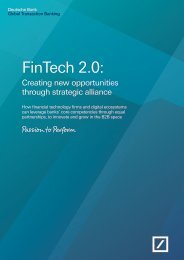Create successful ePaper yourself
Turn your PDF publications into a flip-book with our unique Google optimized e-Paper software.
Exhibit B. What are the innovations?<br />
1<br />
Broad use of<br />
technology across<br />
the whole client<br />
life cycle to deliver<br />
a simplified client<br />
experience<br />
Traditional model Digital innovations Why are they innovative?<br />
Technology is primarily<br />
focused on employee<br />
productivity, regulatory<br />
requirements and integration<br />
of disparate and legacy IT<br />
systems<br />
Well-designed platforms<br />
focused on simplicity, speed<br />
and intuitive workflows<br />
through digital and mobile<br />
offerings<br />
Technology is client-centric<br />
and improves the experience<br />
of financial advice for the<br />
investor<br />
2<br />
Digital delivery<br />
of financial<br />
education and<br />
client-relevant<br />
content<br />
Traditional marketing<br />
and advertising through<br />
brochures, firm website and<br />
direct mail<br />
Compelling editorial content<br />
and financial education<br />
distributed openly online with<br />
focus on human connection;<br />
constant feedback on client’s<br />
financial health<br />
Focusing on the human<br />
connection and financial<br />
education in plain<br />
language through digital<br />
means improves investor<br />
awareness and brings<br />
greater confidence, trust and<br />
engagement<br />
3<br />
Focus on<br />
lower pricing<br />
and greater<br />
transparency<br />
Fees on AUM typically<br />
above 100 basis points;<br />
difficult to understand and<br />
not transparent enough for<br />
investors<br />
Average fees between 25 and<br />
50 basis points; free tools to<br />
analyze fees across accounts<br />
while offering cost-saving<br />
alternatives<br />
Leveraging low-cost ETFs<br />
and stock indexing enables<br />
portfolio diversification at<br />
lower prices with transparent<br />
fee structure<br />
The common characteristic of these<br />
models is the offer of more affordable basic<br />
components of wealth management directly<br />
to consumers in a seamless, scalable and<br />
cost-efficient manner. This is done by<br />
leveraging several key elements, outlined<br />
in Exhibit B:<br />
• Broad use of technology across the whole<br />
client life cycle to deliver a simplified<br />
client experience. Many of the automated<br />
components that firms leverage have<br />
been available in the market for some time<br />
(e.g., online investment proposals, model<br />
management and automatic rebalancing).<br />
Hence, it is the ability to integrate them<br />
in a seamless manner and deliver them<br />
through a simple and intuitive user<br />
interface that creates a scalable and<br />
cost-effective self-service model. The<br />
persistent focus on user-centric design<br />
and continuous innovation that is part<br />
of a technology company’s DNA further<br />
enhances the client experience.<br />
Digital delivery of firms’ education and<br />
client-relevant content. Most established<br />
wealth management firms still print,<br />
fax and mail complex and difficultto-understand<br />
hard copy reports and<br />
statements. Digital entrants, instead, have<br />
enlisted the help of skilled writers and<br />
bloggers to reach their customer base<br />
through meaningful and personal media<br />
content. Emphasizing knowledge-sharing<br />
and education on personal finance (rather<br />
than stock research and market news),<br />
these firms provide useful content online<br />
and through mobile devices in a manner<br />
they believe better aligns with how clients<br />
communicate and collaborate today.<br />
• Focus on lower pricing and greater<br />
transparency. While most of the<br />
established firms are still charging above<br />
1% on assets under management (AUM),<br />
digital entrants are leveraging low-cost<br />
managed ETF and single-stock investment<br />
portfolios that provide asset diversification<br />
with much lower pricing (i.e., less than<br />
30 basis points). Digital entrants are not<br />
only charging lower fees, they are also<br />
providing more transparency, for example,<br />
by exposing how much customers are<br />
paying other financial providers through<br />
online fee analyzers and alerts when new<br />
fees are being charged. This is in stark<br />
contrast to the opaque and complex fee<br />
schedules offered by many traditional<br />
firms, which make it difficult for customers<br />
to understand exactly how much they are<br />
paying for their investment management<br />
and advice.<br />
<strong>Advice</strong> <strong>goes</strong> <strong>virtual</strong> |<br />
5



